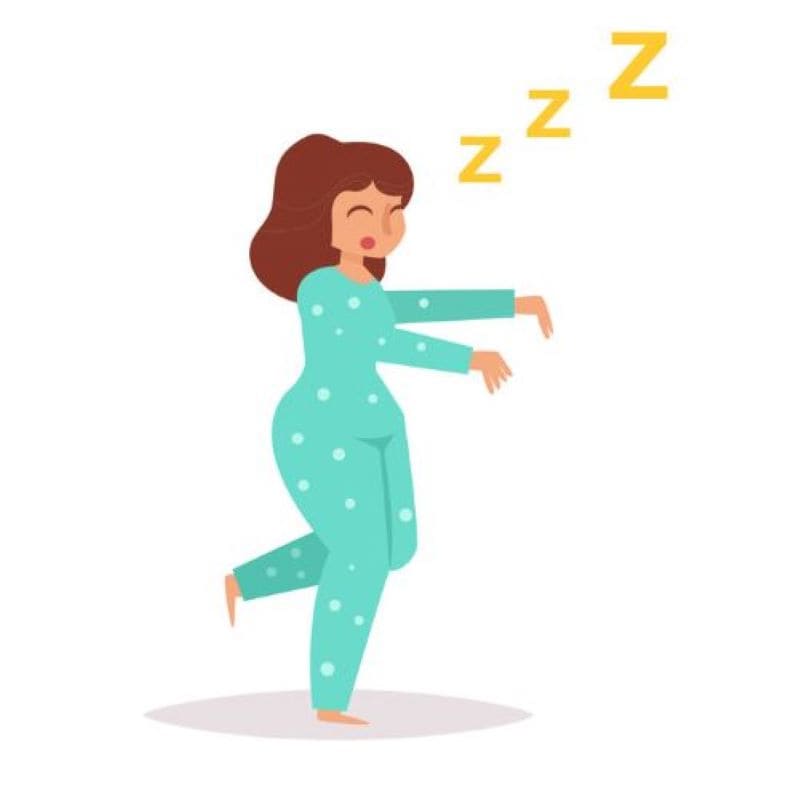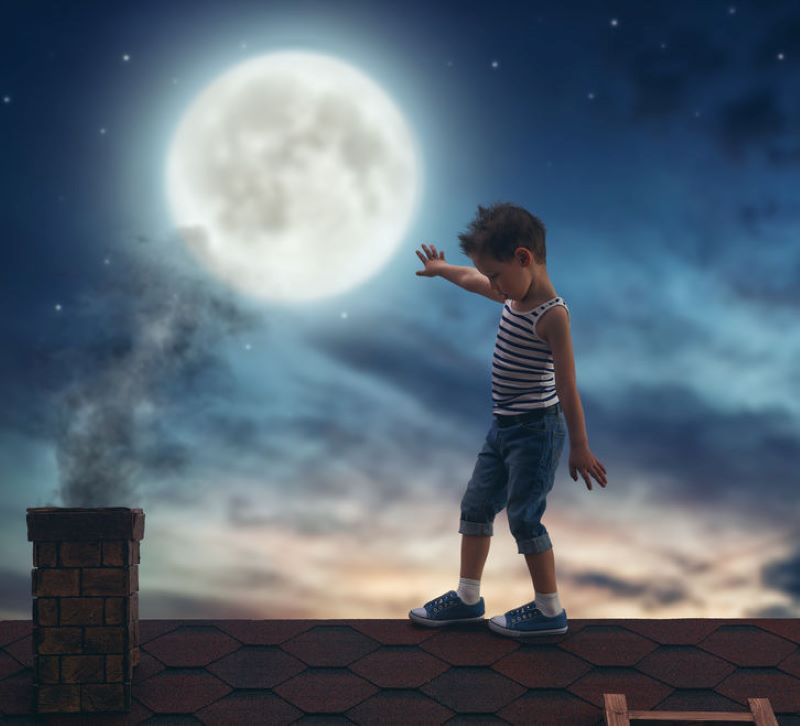He who sleeps walks
Do you like moonlit walks? It is true that a nighttime stroll has its advantages and offers a different perspective on the world around us, not to mention the mysterious, even romantic side of it. However, have you ever walked... while sleeping? You will agree, that is a whole different story. That story is the one lived by people subject to sleepwalking, this peculiar sleep disorder leading to unconscious behavior and performing actions even while asleep. What do we really know about sleepwalking? What does this kind of "unconscious awakening" correspond to? Beyond some myths and urban legends associated with it, sleepwalking is a very interesting subject on which we will try to shed some light. So, are you ready for a little nighttime walk but well illuminated by our investigation?

Sleepwalking, a short path between myths and scientific facts
What is sleepwalking?
Many pathologies or unusual manifestations have sparked all kinds of assumptions or popular beliefs. Just like night terrors or sleep paralysis, sleepwalking is a perfect example, spectacular and difficult to grasp. Before addressing the urban legends related to it, let's be more down-to-earth: what exactly is sleepwalking? It is a somewhat particular sleep disorder. Indeed, it is classified as a parasomnia because it occurs at the boundary between sleep and wakefulness, during the deep slow-wave sleep phase, and it involves abnormal and undesirable motor or psychomotor behavior.
How does sleepwalking manifest?
You are probably wondering what an "undesirable" behavioral event might refer to. In this case, imagine for a moment that you wake up in the middle of the night and, to your great surprise, your beloved is no longer beside you in your bed. Could he (or she, let's respect equality) have spent the night elsewhere without your knowledge? Then you hear a noise coming from your garage. You go there and, to your astonishment, you see your partner getting into the car and starting it, completely ignoring your questions and the sound of your voice… because he is asleep! Or more precisely, he is in that famous unconscious waking state. Examples like this are varied. A sleepwalker can have multiple behaviors ranging from simply sitting on the bed to scan the room with their eyes, to doing the dishes, cleaning, or any other activity, including a random walk, sometimes even leaving their home. It is true that this can have some advantages, especially for those lacking motivation to do household chores, but it can also involve risks in certain situations! In practice, a sleepwalker can perform almost any daily action, and will generally have no memory of it. Moreover, it is not possible to interact with a person experiencing a sleepwalking episode. Indeed, despite their "awake" appearance, they are unconscious and may only respond in a completely incoherent or incomprehensible way.
A sleepwalking episode generally begins between 1 and 3 hours after falling asleep and can last from 5 to 30 minutes on average, which, as you can imagine, leaves plenty of time to wander around or do all sorts of things, even mischief!
Who can be affected by sleepwalking?
This parasomnia can affect anyone. However, sleepwalking tends to concern children more and becomes rarer upon reaching adulthood. Studies estimate on average the prevalence of sleepwalking1 at 2% of adults and 5% of children. The prevalence peak2 for children would be around the age of 10, with on average 13% of our young toddlers facing sleepwalking episodes.
Regarding gender, sleepwalking would be fairly equal if we believe a Finnish study3, since it reveals a prevalence of 3.9% in men and 3.1% in women. However, other research4 may show a slightly higher incidence in men than in women, without the difference being truly significant.
Do we know the causes of sleepwalking?
Throughout history, sleepwalking has sparked scientific questions and popular beliefs. While it is an interesting, even fascinating subject, the exact causes of sleepwalking remain uncertain, at least until a few years ago. Fortunately, some recent studies have shed more light on the sometimes obscure and mysterious path of sleepwalking.
First of all, as reported by the referenced site "Sleep Foundation"5, correlations have been established between sleepwalking and the following factors or pathologies:
- lack of sleep: it leads to spending more time in deep sleep phase to "recover," thus increasing the risks of sleepwalking episodes
- medication intake: medications such as sleeping pills cause excess sleep favorable to sleepwalking
- alcohol consumption: adverse effects on sleep quality with disturbances during different phases, leading to fragmentation of slow waves conducive to sleepwalking
- stress: promotes sleepwalking due to fragmented sleep
Regarding the "lack of sleep" factor, a study6 went further by concluding that beyond the risks related to sleep deprivation, a forced or abrupt awakening could significantly increase the chances of experiencing a sleepwalking episode… for predisposed individuals! It is indeed important to specify this point because it is the discovery of this "predisposition to sleepwalking" that advanced the understanding, and which, hopefully, may help better understand this parasomnia in the coming years.
For those who don't know the "schmilblick" (and its established expression), some research will be necessary. A bit of general culture is always good to have!
A genetic predisposition to sleepwalking?
The discovery of a hereditary factor has shed light on what is probably, along with lack of sleep, the main cause of sleepwalking. According to a study from 20037, it is estimated that family history is found in nearly 80% of sleepwalkers. Moreover, as revealed by an article from "Medical Express"8, researchers from the neurology department of the prestigious "Washington University School of Medicine" succeeded in highlighting and identifying the chromosome responsible for a genetic transmission predisposing to sleepwalking: it would be chromosome "20q12-q13.12" (gene "HLA DQB1*05", involved in immune system regulation). Furthermore, their study9 determined that an individual prone to sleepwalking episodes possessing this particular form of chromosome 20 had nearly a 50% chance of passing it on to their offspring.
That is interesting and could help prevent, or at least limit, certain untimely nighttime walks or activities in the future!
Sleepwalking in popular beliefs
To continue our nighttime walk on a lighter note, but still well illuminated, let's pause for a moment on some popular beliefs about sleepwalking. Which are true, which are false? Here are some answers just for you, dear night rebels:
- "A sleepwalker can die if awakened": no, however they could be in a state of more or less strong confusion which may cause sudden and disorderly reactions
- "Sleepwalkers always keep their eyes closed": no, otherwise how could they move? In reality, their eyes are sometimes not always fully open, but a sleepwalker moving with eyes closed is only to scare in certain movies!
- "People who are subject to it experience sleepwalking episodes every day": no, not necessarily. Indeed, the frequency of episodes mainly depends on the level of stress factors and lack of sleep
- "'Sleepwalkers cannot hurt themselves': should we really respond? Of course, sleepwalkers are not superheroes; they can hurt themselves, injure themselves, or even hurt someone else (we will come back to this!)
Besides these few beliefs (among others), sleepwalking has also been the subject of mystification over the past centuries. Imagine, a few hundred years ago, the incredulous or fearful reactions to a person walking while asleep, even though today science still struggles to explain it. People then spoke of spirits and possession: "The emergence of the possession myth dates back to the Middle Ages," explains Édouard Collot, psychiatrist specialized in hypnotherapy and author, with Bertrand Hell, of Soigner les âmes (Dunod). "This type of belief rooted in the cultural foundation means that the sleepwalker can be likened to a possessed person."
Art, and literature in particular, has been influenced by certain sleep disorders, including sleepwalking. For example, the character of MacBeth in William Shakespeare's eponymous play (second culture point!). This is also the case in the 7th art, where some horror films and thrilling thrillers have portrayed (sometimes) very inspired sleepwalkers ("The Sleepwalker," 1997 film by John Cosgrove, starring Hillary Swank)!
How can sleepwalking be treated?
While inspiring for literature, cinema, or some urban legends, sleepwalking should not be taken lightly. Certainly, it can lead to sometimes comical scenes, but in some cases, it can be distressing and even dangerous. This is called risky sleepwalking. The sleepwalker can indeed be dangerous to themselves, by falling down stairs, falling out of windows, cutting themselves with a knife, or through many other actions. Unfortunately, they can also be dangerous to those around them: some sleepwalkers exhibit aggressive behaviors, may perform violent and disorderly acts, or simply be clumsy.
Elsewhere, a particular form of sleepwalking is associated with sexual behavior: this is sexomania. During an "episode" of this particular sleepwalking, the individual may engage in sexual behaviors alone, just as they can be proactive, even sexually aggressive towards someone. Numerous case studies have multiplied in recent years, notably by Prof. Shapiro10. Some cases of sexomania-type assaults, akin to rape, have even been subject to legal proceedings.
As we can see, sleepwalking is not trivial. Some consequences of its manifestations can be serious (injuries, accidents, violent behaviors), even if risky sleepwalking is fortunately not the most common. Faced with the inconveniences and risks of certain related behaviors, is it possible to prevent or treat sleepwalking?

Unfortunately, there is no officially recognized treatment for sleepwalking. However, and fortunately, it is possible to limit the frequency and duration of sleepwalking episodes, even in the most severe cases. These cases are, however, quite rare in adults (less than 2%). In any case, before considering any medication, here are some tips to act on the main factors related to sleepwalking:
- adopt good sleep hygiene: avoid an excessively long duration of deep sleep (which favors sleepwalking) by having a sufficient daily amount of sleep so as not to have to "catch up" on sleep deprivation
- carry out scheduled awakenings: 15 to 20 minutes before the usual observed time of episode onset, when possible
- treat sleep disorders or diseases that fragment deep sleep: sleep apnea, restless legs syndrome...
- resort to hypnosis sessions : the effectiveness of hypnosis to limit the impact of sleepwalking is recognized by numerous studies11
- secure the environment: close doors and windows, hide car keys and dangerous objects...
In particularly difficult cases, the use of medication, more specifically benzodiazepines or antidepressants, known to limit deep slow-wave sleep, can be considered. However, beware of the risks of dependence and some undesirable side effects.
A phenomenon as mysterious as it is spectacular, inspiring for popular culture and increasingly researched by science, this parasomnia cannot be ignored and requires certain attention. Sleepwalking is a drowsy stroll that sometimes is far from a walk in the park! So, let's hope that recent discoveries about genetic predispositions help us better understand it in the future.
Additionally, and to better illustrate the topic of this article, we offer you a short and nice video, right here, published by the channel "Life Noggin".
Third cultural point, for those who want to get some chills watching an excellent Scandinavian thriller with sleepwalking as the main theme, we recommend the film "Sleepwalker".
Sources:
[1] Prevalence of Sleepwalking: A Systematic Review and Meta-Analysis, Helen M. Stallman and Mark Kohler, "Plos One", 2016 [2] Childhood Sleepwalking and Sleep Terrors: A Longitudinal Study of Prevalence and Familial Aggregation, Dominique Petit, Marie-Hélène Pennestri et al, "JAMA Pediatrics", July 2015 [3] Prevalence and Genetics of Sleepwalking, C. Hublin, J. Kaprio et al, "Neurology", January 1997 [4] Prevalence of sleepwalking in an adult population, Celestine Okorome Mume, "Libyan Journal of Medicine", January 2010 [5] Sleepwalking, site "Sleep Foundation", 2020 [6] Precipitating factors of somnambulism: impact of sleep deprivation and forced arousals, Mathieu Pilon, Jacques Montplaisir et al, "Neurology", June 2008 [7] HLA and genetic susceptibility to sleepwalking, M Lecendreux, C Bassetti et al, "Molecular Psychiatry", 2003 [8] Scientists find genetic basis for sleepwalking, site "Medical Xpress", February 2011 [9] Novel genetic findings in an extended family pedigree with sleepwalking, A.K. Licis, MD, D.M. Desruisseau et al, "Neurology", January 2011 [10] Sexsomnia: a new parasomnia?, Colin M Shapiro, Nikola N Trajanovic et al, "Revue Canadienne de Psychiatrie", June 2003


